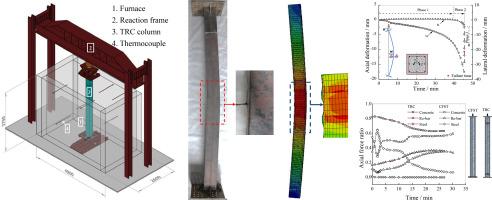当前位置:
X-MOL 学术
›
J. Constr. Steel Res.
›
论文详情
Our official English website, www.x-mol.net, welcomes your
feedback! (Note: you will need to create a separate account there.)
ISO 834 standard fire test and mechanism analysis of square tubed-reinforced-concrete columns
Journal of Constructional Steel Research ( IF 4.0 ) Pub Date : 2020-12-01 , DOI: 10.1016/j.jcsr.2020.106316 Dongdong Yang , Faqi Liu , Shan-Shan Huang , Hua Yang
Journal of Constructional Steel Research ( IF 4.0 ) Pub Date : 2020-12-01 , DOI: 10.1016/j.jcsr.2020.106316 Dongdong Yang , Faqi Liu , Shan-Shan Huang , Hua Yang

|
Abstract The tubed-reinforced-concrete (TRC) column is an innovative steel-concrete composite column and its steel tube is terminated at beam-to-column connections to mainly work as hoop reinforcements without sustaining axial load directly. Fire performance of TRC columns differs from that of concrete-filled steel tubular (CFST) columns since the axial deformation behaviour of the TRC columns would mainly depend on the inner reinforced concrete and local buckling of steel tube is minimised. However, no research has been reported on the behaviour of square TRC columns under fire exposure. Five slender square TRC columns subjected to standard fire and axial loading were tested in this study and the effects of load ratio and load eccentricity were investigated. Failure mode of the test specimens was dominated by global flexural buckling, whereas tube local buckling was also observed. The experimental results show that load ratio has a significant influence on the fire resistance of test specimens while the influence of load eccentricity is marginal. A sequentially-coupled thermo-mechanical finite element analysis (FEA) model was developed using ABAQUS. This FEA model was validated well against the test results when using the measured column end rotations as realistic boundary conditions. Different from the case of a CFST column, the axial load applied to a TRC column in fire is mainly sustained by the concrete and reinforcing bars and the high-temperature capacity contribution of steel tube is neglectable. With the increase of exposure time, the applied load gradually transfers from concrete to reinforcements until the yielding of re-bars.
中文翻译:

ISO 834 标准防火测试和方管钢筋混凝土柱的机理分析
摘要 管钢筋混凝土柱是一种新型的钢-混凝土组合柱,其钢管端接于梁柱连接处,主要用作箍筋,不直接承受轴向荷载。TRC 柱的防火性能不同于钢管混凝土 (CFST) 柱,因为 TRC 柱的轴向变形行为主要取决于内部钢筋混凝土,并且钢管的局部屈曲被最小化。然而,没有关于方形 TRC 柱在火灾暴露下的行为的研究报告。在这项研究中测试了五个细长方形 TRC 柱承受标准火灾和轴向载荷,并研究了载荷比和载荷偏心的影响。试样的破坏模式以整体弯曲屈曲为主,而管局部屈曲也被观察到。试验结果表明,荷载比对试件的耐火性能有显着影响,而荷载偏心的影响很小。使用 ABAQUS 开发了一个顺序耦合的热机械有限元分析 (FEA) 模型。当使用测量的柱端旋转作为实际边界条件时,该 FEA 模型根据测试结果得到了很好的验证。与CFST柱的情况不同,火灾中作用于TRC柱的轴向荷载主要由混凝土和钢筋承受,钢管的高温承载力贡献可忽略不计。随着暴露时间的增加,施加的荷载逐渐从混凝土转移到钢筋,直到钢筋屈服。试验结果表明,荷载比对试件的耐火性能有显着影响,而荷载偏心的影响很小。使用 ABAQUS 开发了一个顺序耦合的热机械有限元分析 (FEA) 模型。当使用测量的柱端旋转作为实际边界条件时,该 FEA 模型根据测试结果得到了很好的验证。与CFST柱的情况不同,火灾中作用于TRC柱的轴向荷载主要由混凝土和钢筋承受,钢管的高温承载力贡献可忽略不计。随着暴露时间的增加,施加的荷载逐渐从混凝土转移到钢筋,直到钢筋屈服。试验结果表明,荷载比对试件的耐火性能有显着影响,而荷载偏心的影响很小。使用 ABAQUS 开发了一个顺序耦合的热机械有限元分析 (FEA) 模型。当使用测量的柱端旋转作为实际边界条件时,该 FEA 模型根据测试结果得到了很好的验证。与CFST柱的情况不同,火灾中作用于TRC柱的轴向荷载主要由混凝土和钢筋承受,钢管的高温承载力贡献可忽略不计。随着暴露时间的增加,施加的荷载逐渐从混凝土转移到钢筋,直到钢筋屈服。
更新日期:2020-12-01
中文翻译:

ISO 834 标准防火测试和方管钢筋混凝土柱的机理分析
摘要 管钢筋混凝土柱是一种新型的钢-混凝土组合柱,其钢管端接于梁柱连接处,主要用作箍筋,不直接承受轴向荷载。TRC 柱的防火性能不同于钢管混凝土 (CFST) 柱,因为 TRC 柱的轴向变形行为主要取决于内部钢筋混凝土,并且钢管的局部屈曲被最小化。然而,没有关于方形 TRC 柱在火灾暴露下的行为的研究报告。在这项研究中测试了五个细长方形 TRC 柱承受标准火灾和轴向载荷,并研究了载荷比和载荷偏心的影响。试样的破坏模式以整体弯曲屈曲为主,而管局部屈曲也被观察到。试验结果表明,荷载比对试件的耐火性能有显着影响,而荷载偏心的影响很小。使用 ABAQUS 开发了一个顺序耦合的热机械有限元分析 (FEA) 模型。当使用测量的柱端旋转作为实际边界条件时,该 FEA 模型根据测试结果得到了很好的验证。与CFST柱的情况不同,火灾中作用于TRC柱的轴向荷载主要由混凝土和钢筋承受,钢管的高温承载力贡献可忽略不计。随着暴露时间的增加,施加的荷载逐渐从混凝土转移到钢筋,直到钢筋屈服。试验结果表明,荷载比对试件的耐火性能有显着影响,而荷载偏心的影响很小。使用 ABAQUS 开发了一个顺序耦合的热机械有限元分析 (FEA) 模型。当使用测量的柱端旋转作为实际边界条件时,该 FEA 模型根据测试结果得到了很好的验证。与CFST柱的情况不同,火灾中作用于TRC柱的轴向荷载主要由混凝土和钢筋承受,钢管的高温承载力贡献可忽略不计。随着暴露时间的增加,施加的荷载逐渐从混凝土转移到钢筋,直到钢筋屈服。试验结果表明,荷载比对试件的耐火性能有显着影响,而荷载偏心的影响很小。使用 ABAQUS 开发了一个顺序耦合的热机械有限元分析 (FEA) 模型。当使用测量的柱端旋转作为实际边界条件时,该 FEA 模型根据测试结果得到了很好的验证。与CFST柱的情况不同,火灾中作用于TRC柱的轴向荷载主要由混凝土和钢筋承受,钢管的高温承载力贡献可忽略不计。随着暴露时间的增加,施加的荷载逐渐从混凝土转移到钢筋,直到钢筋屈服。











































 京公网安备 11010802027423号
京公网安备 11010802027423号